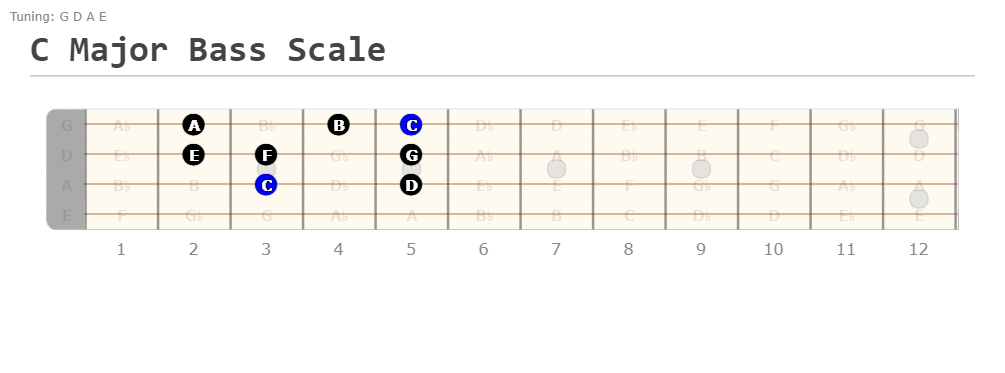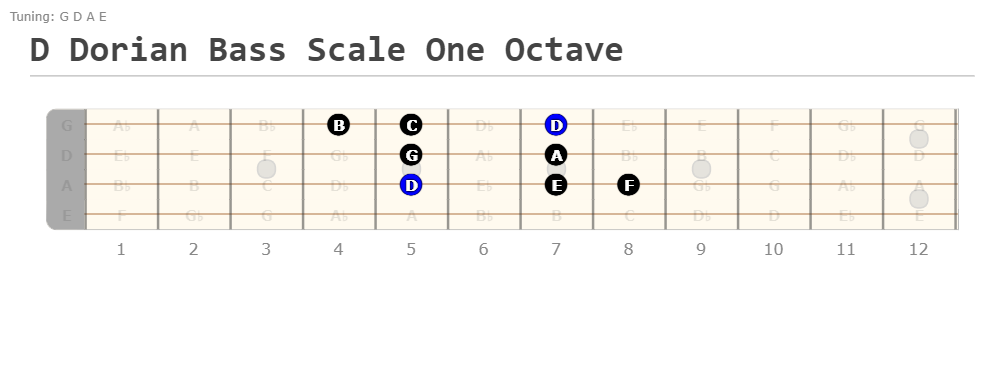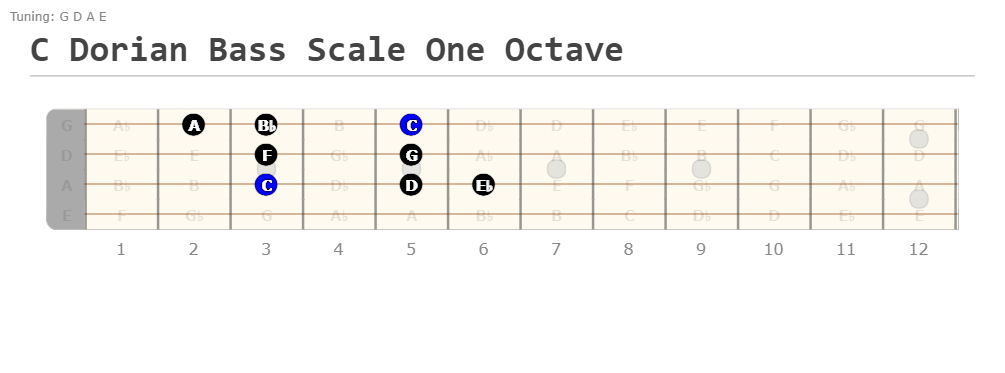Introduction to the Dorian mode
The Dorian bass mode is one of my favorite modes for bass guitar due to its funky, yet obscure sounding nature.
In this lesson you’ll learn what Dorian is, the Dorian bass scale sequence, and look at a fretboard diagram to help you visualize Dorian.
Table of Contents
What is the Dorian mode?
The Dorian bass mode is the 2nd mode of the major scale and is commonly used over minor 7th chords because of its harmonic structure.
Being the 2nd mode of the major scale simply means the Dorian bass scale is built from the 2nd degree of the major scale.
You’ll see this put into practice in the upcoming examples.
The odd naming of Dorian
The Dorian mode got its name from the Dorian Greeks, an ethnic group in ancient Greece.
Music theory is deeply rooted in Ancient Greek history, and that’s where this name comes from.
Dorian scale formula and interval structure
The Dorian scale formula is:
1-2-b3-4-5-6-b7
The major 6th is the single interval that sets the Dorian mode apart from the Aeolian mode (the minor scale).
Constructing Dorian in whole and half steps
Here’s the Dorian mode constructed in whole and half steps:
W-H-W-W-W-H-W
This means you can pick any root note, follow this pattern of whole and half steps, and when resolving on the root note you will have played through a Dorian scale!
If you know your major scale whole and half-step sequence, you can think of the Dorian scale sequence as starting from the 2nd degree of the major scale sequence, but remember to put that initial whole step at the end!
Applying Dorian
Dorian is considered a minor mode, because its root chord is a minor triad.
When adding the b7 degree to the root chord, you get a minor 7th chord.
This means that Dorian is used over minor chords and minor 7th chords possessing the same root. It can also sound great over any extended minor chord, such as minor 9th, minor 11th, and minor 13th chords.
As a matter of fact, since it’s the only minor mode with a major 6th interval (AKA the 13th), it’s the best modal candidate to use over a minor 13th chord.
If you need a refresher, here’s a minor 13th chord formula:
1-b3-5-b7-9-11-13
As you can see from the Dorian mode formula, it possesses all of these intervals.
C Major Scale Bass
Here’s the C major bass scale, which you’ll use as a reference for understanding Dorian.
If you don’t know, the interval structure of the major scale has no sharps or flats. The scale formula is 1-2-3-4-5-6-7.
Notes in C major
C-D-E-F-G-A-B

D Dorian
Here’s the D Dorian bass scale.
This is the 2nd mode of the C major scale (shown above). You can derive the Dorian mode from the C major scale or any other major scale by building the scale from the 2nd degree.
As you can see, D Dorian has the same notes as the C major scale, but D is used as the root note.
Since D is the new root note, the interval structure changes in the scale sequence! The new structure is the Dorian scale sequence: 1-2-b3-4-5-6-b7
Notes in D Dorian
D-E-F-G-A-B-C

C Dorian Scale Bass
Here’s the C Dorian bass scale.
This is often referred to as the parallel mode for the C Ionian (major) mode/scale.
As you can see, the two intervals that have changed relative to the C major scale are the Db and Bb. These are the b3 and b7 intervals, which you’ve learned is what sets Dorian apart from Ionian (major).
Notes in C Dorian
C-Db-E-F-G-A-Bb

C Dorian Bass Mode Fretboard Diagram
Here’s a complete C Dorian bass mode/ scale diagram, with the intervals.
Even though I used note names in the above examples, it’s also good and important to analyze the mode by looking at it’s interval structure across the fretboard.
Particularly, pay attention to and practice different fingerings from the root positions. Learn to recognize where the 6th interval is relative to the root note, which will help you contextualize Dorian.

Conclusion: Practicing the Dorian Bass Mode
Now that you’ve learned some Dorian bass scale shapes, it’s time to put them into practice!
When practicing the Dorian mode pay attention to how the major 6th sounds relative to a minor chord, minor 7th chord, or extended minor chord with the same root note. This is the defining interval in Dorian, afterall.
Start by practicing with the D Dorian scale, because all of it’s notes are natural, which makes it easier to understand. Plus, you may already be familiar with the notes of this mode if you know your C major scale.
From there you can practice using C Dorian, the Dorian mode parallel to C Major. This will help you understand how simple it is to transpose from one mode to another, simply moving the major 3rd and major 7th intervals down a half step to produce Dorian rather than Ionian.
Looking for Dorian backing tracks on YouTube will be hugely beneficial in practicing the Dorian mode for bass guitar, so I suggest it.
What’s next?
Looking for some other bass scales to master? Then check out these 2 lessons:

